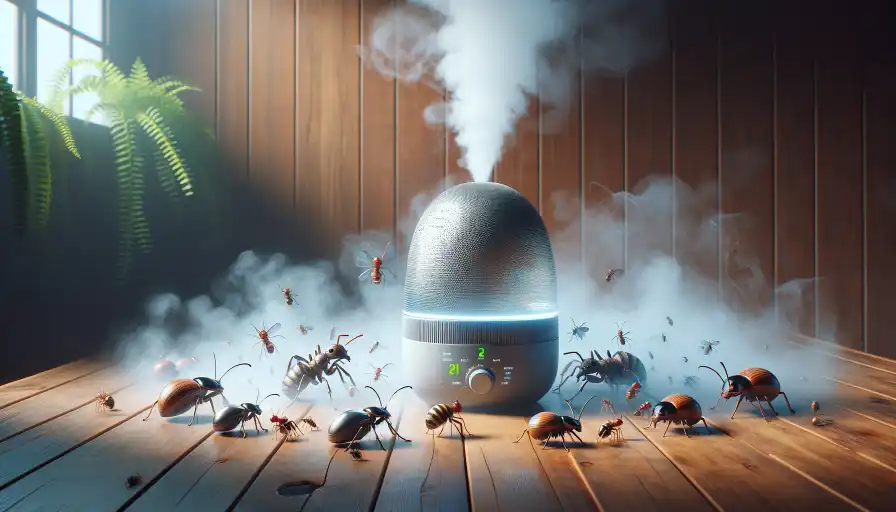Yes, the presence of bugs around humidifiers is indeed a possibility, though it’s a complex relationship that hinges on various factors. The reason behind this is multifaceted:
Firstly, humidifiers work by boosting the moisture in the air, thereby increasing the humidity of the environment. This heightened humidity can be inviting to bugs, as they are naturally drawn to moist areas. However, not every bug favors humid conditions. For instance, certain spiders rely on moisture to produce silk for their webs, making a humid room ideal for them. Roaches, too, are commonly found in damp locations like bathrooms and kitchens. Other insects like earwigs, moisture ants, and termites also prefer humid environments, with earwigs looking for damp hiding spots and moisture ants and termites thriving in wet wood.

The maintenance of your humidifier also plays a pivotal role. Keeping it clean is vital; otherwise, it could become a hotbed for molds and bacteria, which in turn can attract bugs. As for the ideal humidity level, aiming for a range between 30% and 50%, as recommended by the United States Environmental Protection Agency, is advisable. Excessive humidity, especially above 60%, can foster mold growth and further attract bugs.
Do Humidifiers Attract Roaches?
Yes, humidifiers can attract roaches. Roaches are attracted to moist and humid environments because they need water to survive. When a humidifier increases the humidity level in a room, it makes the environment more appealing to roaches, especially if the humidity is consistently high.
Do Humidifiers Attract Spiders And Other Bugs?
Yes, humidifiers can attract spiders, but like with roaches, the attraction is more about the environment the humidifier creates rather than the device itself. Spiders are often drawn to humid areas because they prefer environments that support their prey, like other small insects, which are also attracted to moisture. Additionally, some types of spiders need a certain level of humidity to help them spin their webs more effectively.
Maintaining And Cleaning Humidifier For Bug-Free Home
Here’s how to keep your humidifier clean and bug-free:
Disassemble the Humidifier:
- Unplug the machine and empty the water tank.
- Detach any removable parts, including the air filter if your humidifier has one.
Clean with Vinegar:
- Pour white vinegar into the tank, covering areas that come in contact with water.
- Let it sit for at least 20 minutes to break down any scale buildup.
- Use a soft-bristled brush to remove residue from the tank and other components.
Disinfect with Bleach:
- After vinegar cleaning, use a bleach solution to kill lingering bacteria.
- Mix 1 teaspoon of liquid chlorine bleach with 1 gallon of cold water.
- Fill the humidifier tank halfway with the solution and coat the inside.
- Let it stand for 20 minutes.
Regular Maintenance:
- Clean your humidifier weekly during heavy use (such as winter) using vinegar or hydrogen peroxide.
- Perform a monthly deep clean of the tank, base, and filter (follow manufacturer’s instructions).
- Replace the humidifier when necessary
Do Dehumidifiers Attract Bugs?
No, dehumidifiers generally do not attract bugs. In fact, they often have the opposite effect. Dehumidifiers work by reducing the humidity levels in your home, making the environment less appealing to many types of bugs that thrive in moist conditions.
Pests like roaches, spiders, silverfish, and earwigs prefer humid environments because they need moisture to survive. By lowering the humidity level, a dehumidifier can make your home less attractive to these pests. This can be particularly effective in damp areas of your home, like basements, bathrooms, and kitchens, where these pests are more likely to congregate.
Do Humidifiers Keep Bugs Away
No, humidifiers generally do not keep bugs away. In fact, they can sometimes attract bugs. Humidifiers increase the moisture level in the air, creating a more humid environment. Many types of bugs are attracted to moisture because they need it to survive. This includes common household pests like roaches, spiders, and silverfish.
If the humidity in a room becomes too high, it can create an ideal environment for these pests. It’s especially important in areas like kitchens and bathrooms, where moisture levels are already higher.
How to Avoid Bugs And Pests While Using a Humidifier or Dehumidifier?
To avoid attracting bugs and pests while using a humidifier or dehumidifier, you can follow these tips:
Maintain Ideal Humidity Levels:
- For humidifiers, keep the indoor humidity between 30% and 50%. This level is comfortable for humans but less attractive to pests.
- For dehumidifiers, aim to reduce high humidity levels, particularly in damp areas like basements and bathrooms. This makes the environment less hospitable for pests that thrive in moisture.
Regular Cleaning and Maintenance:
- Clean your humidifier or dehumidifier regularly following the manufacturer’s instructions. Dirty humidifiers can breed mold and bacteria, attracting pests.
- Change the water in humidifiers daily to prevent stagnant water, which can attract bugs.
Proper Placement:
- Place humidifiers and dehumidifiers away from walls and corners where pests like to hide.
- Ensure they are not near any food sources or waste areas that might already be attracting pests.
Seal Entry Points:
- Check for and seal any cracks or gaps in windows, doors, and walls to prevent pests from entering.
Use Pest Repellents:
- Consider using natural pest repellents like essential oils near the device. Some oils, like peppermint or lavender, are known to repel certain insects.
Monitor Water Leakage:
- Ensure your dehumidifier’s water collection area is not leaking, as standing water can attract pests.
Proper Ventilation:
- Ensure your home is well-ventilated. Good air circulation can help maintain balanced humidity levels and reduce the likelihood of creating pest-friendly environments.
